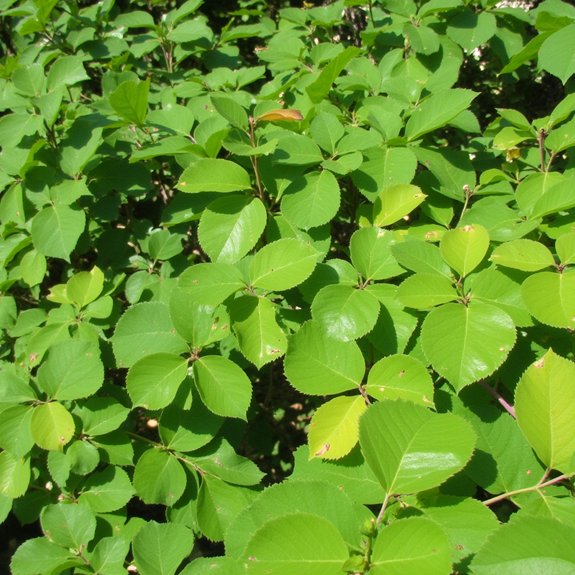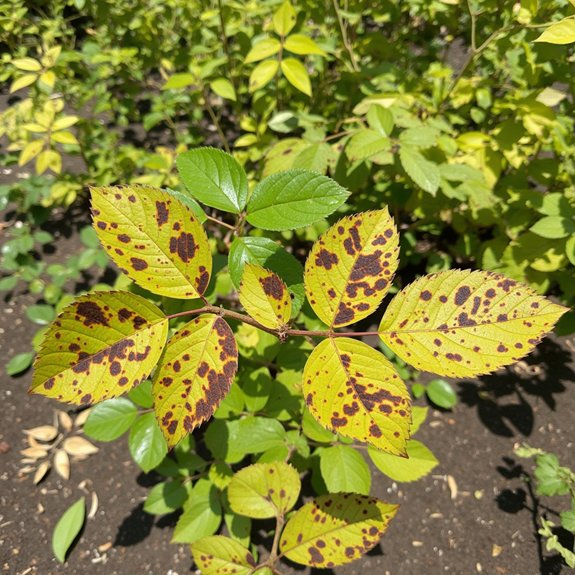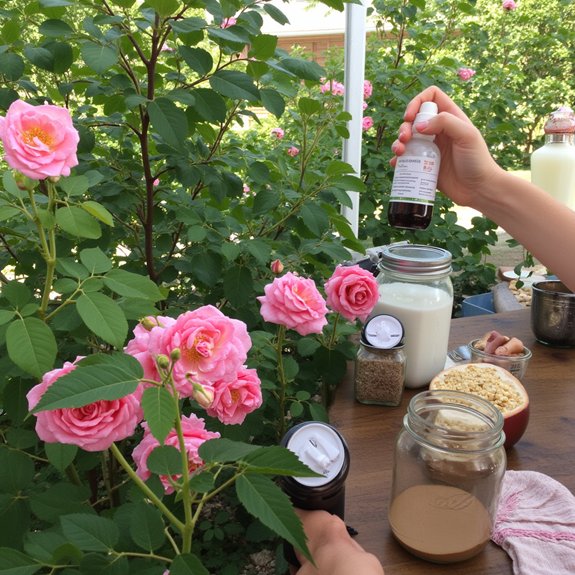Imagine this: you’ve spent months nurturing your prize roses, only to watch helplessly as dark, circular spots creep across their leaves like unwelcome graffiti on a masterpiece. Black spot disease affects up to 80% of rose gardens nationwide, turning your blooming sanctuary into a frustrating battlefield. You’re not powerless against this persistent fungal invader, though. With the right combination of prevention tactics, organic treatments, and strategic cultural practices, you’ll transform your struggling roses into disease-resistant champions.
Contents
- 1 Understanding the Black Spot Fungal Disease
- 2 Identifying Key Symptoms and Warning Signs
- 3 Root Causes Behind Black Spot Development
- 4 Prevention Strategies for Healthy Roses
- 5 Organic Treatment Methods and Natural Solutions
- 6 Synthetic Treatment Options for Severe Cases
- 7 Cultural Practices for Long-Term Management
- 8 Building Disease Resistance in Your Rose Garden
Understanding the Black Spot Fungal Disease

When you notice irregular black and brown splotches appearing on your rose leaves, you’re likely dealing with black spot, a fungal disease caused by Diplocarpon rosae. This persistent fungus thrives in wet conditions, spreading through wind and water droplets to infect your plants.
The fungal life cycle accelerates when environmental factors align perfectly: high humidity, poor air circulation, and prolonged moisture on foliage. You’ll first see symptoms on lower leaves as yellowing surrounds dark spots, eventually causing leaf drop that weakens your roses and moves progressively upward through the plant.
Identifying Key Symptoms and Warning Signs
How can you distinguish black spot from other rose diseases before it devastates your garden? Start with symptom identification on your rose’s older, lower leaves. You’ll notice irregular splotches displaying black, brown, or purplish colors that look nothing like perfect circles. Watch for warning signs like yellowing tissue surrounding these spots, followed by inevitable leaf drop. The fungus travels upward, so check your plant’s progression from bottom to top. Fresh canes develop brown, rust-colored scabs that might confuse you with rose canker, but black spot’s scabs appear more scattered and less defined than canker’s precise lesions.
Root Causes Behind Black Spot Development

Although black spot appears suddenly, it typically develops from five specific environmental conditions that you can control. Wet conditions from prolonged moisture on foliage create the perfect breeding ground for Diplocarpon rosae fungus. Your watering practices contribute notably when you water overhead, keeping leaves damp for extended periods.
Poor air circulation from overcrowded plantings prevents leaves from drying quickly. Shady locations compound this problem by blocking sunlight that naturally dries foliage. Finally, inadequate sanitation spreads spores through contaminated tools and debris, allowing the disease to jump between plants and establish itself throughout your garden.
Prevention Strategies for Healthy Roses
Since black spot thrives in predictable conditions, you can prevent most outbreaks by choosing the right roses and creating an environment where the fungus can’t establish itself. Start with disease-resistant varieties—they’re your best defense for long-term rose health. Space plants 3-4 feet apart to guarantee proper airflow, which keeps leaves dry and prevents fungal growth.
Water at the base, never overhead, to avoid wet foliage. Prune regularly to maintain an open, vase-like shape that promotes circulation. Clean up fallen leaves and debris promptly, and sanitize your pruning tools between cuts to prevent spreading spores throughout your garden.
Organic Treatment Methods and Natural Solutions

When black spot does appear on your roses, organic treatments can effectively control the spread without harsh chemicals. These natural fungicides work by creating protective barriers on leaves and disrupting fungal growth patterns.
Mix two teaspoons of baking soda with two teaspoons of vegetable oil in one gallon of water. This homemade remedy coats plants, inhibiting further infection. Alternatively, combine one part milk with two parts water for weekly applications after removing infected foliage.
Neem oil provides another excellent option: add two to five tablespoons per gallon of water. Apply these treatments in evening hours to protect beneficial pollinators while targeting the fungus.
Synthetic Treatment Options for Severe Cases
For gardeners facing persistent black spot infections that resist organic methods, synthetic fungicides offer more aggressive intervention. Begin with severity assessment—examine how much foliage you’ve lost and whether the infection spreads despite organic treatments.
Hard pruning removes diseased material while encouraging fresh growth. Consider replacing particularly susceptible varieties with disease-resistant alternatives instead of repeated chemical applications.
When applying synthetic treatments, wear gloves, eye protection, and masks. Spray during evening hours to protect pollinators. Popular options include Daconil multipurpose fungicide and BioAdvanced systemic disease control, both targeting stubborn fungal infections effectively.
Cultural Practices for Long-Term Management
While synthetic treatments tackle immediate black spot problems, establishing proper cultural practices creates lasting protection that prevents future outbreaks. Focus on soil health first—well-draining, nutrient-rich soil strengthens your roses’ natural defenses against fungal diseases.
Companion planting works wonders for prevention. Plant lavender, marigolds, or chives around your roses to improve air circulation and deter harmful insects. Space roses 3-4 feet apart, ensuring adequate airflow between plants.
Water at soil level using drip irrigation or soaker hoses, avoiding overhead sprinklers that wet foliage. Prune annually to maintain that essential vase shape, removing weak or crossing branches that block airflow.
Building Disease Resistance in Your Rose Garden
Although prevention forms your first line of defense, building true disease resistance requires selecting the right rose varieties and strengthening their natural immunity. Choose proven disease-resistant cultivars like ‘Knock Out,’ ‘Double Delight,’ or ‘Mr. Lincoln’ when planting new roses. These varieties naturally resist black spot, reducing your maintenance workload.
You can also boost existing roses’ immunity through proper nutrition. Feed them balanced fertilizer monthly during growing season, and guarantee they’re planted in well-draining soil with adequate sunlight. Healthy, well-nourished plants develop stronger natural defenses against fungal infections, making your garden more resilient long-term.
